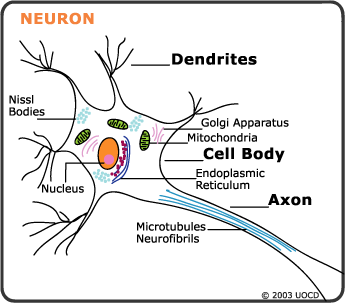The Working Of Neurons.
In depth look at how neurons work in the human brain, and how this relates to OCD.
How Do Neurons Work?
The part you will have to understand in order to comprehend the workings of Serotonin are NEURONS.
What are Neurons?A human brain is made up out of approximately 100- billion (10,000,000,000.) nerve cells which are called NEURONS which transmit nerve impulses. There are about 4 million miles of nerve fibre in a brain, with some fibres having as many as 10.000 branches.
 Cell Body:
Cell Body:These NEURONS are able to transmit and gather electrochemical signals. A NEURON is built up like any other cell but due to the electrochemical aspect it is able to send signals over long distances ( up to several feet or a few meters) and pass messages to each other.
A NEURON has 3 parts to it:
- A Cell Body: containing a nucleus (contains DNA), endoplastic reticulum, mitochondria and other organelles typically found in eukaryotic cells.
- The Dendrites: Bringing information TO the cell body. They are like small branches, allowing to connect to more than 1 other neuron. They are what allow the neuron to talk to other cells or perceive the environment.
- The Axon: Nerve Fibre, is the longest fibre of the NEURON which brings information AWAY from the cell body to the connecting NEURON.
NEURONS vary in the amount of information they transmit or receive, some having many connections to others and thus receiving thousands of messages and others only having a few.
How Do Neurons Communicate?
We already know that the information is handled by gathering and sending electrochemical signals, now we have to see how this works.
In order for neurons to be able to communicate, an electrical impulse travels down an axon and to the synaptic terminal ( PRESYNAPATIC ENDING).
But the endings of neurons don't actually touch each other and this small gap between 2 neurons, combined with the endings is called: the SYNAPSE.
In order for any data to be transmitted from 1 neuron to the other, the electrical signal that went through the AXON now has to jump across the SYNAPTIC CLEFT.
A synapse consists of 3 parts:
- A presynaptic ending: containing neurotransmitters.
- A postsynaptic ending: containing receptor sites for the neurotransmitters and:
- A synaptic cleft: or space between the presynaptic and post synaptic endings.
So now the electrical signal that ran down the AXON has to cross a gap and this requires the chemical action of neurotransmitters such as SEROTONIN.
How Does This Message Get Across?
This is where the electrical message now becomes a chemical 1, the chemicals used are called neurotransmitters. At the synaptic terminal the electrical impulse triggers the migration of small synaptical vesicles (found in the tip of the Axon) which contain neurotransmitters toward the presynaptic membrane. The vesicle's membrane will fuse with the presynaptic membrane and this allows the release of the neurotransmitters into the gap.
The neurotransmitters molecules now diffuse across the synaptic cleft where they can bind with receptor sites (proteins) on the post synaptic ending now triggering an electrical response in the post synaptic neuron.
(This post synaptic ending can be either a dendrite, axon or a cell body.)
The neurotransmitter which were attracted by the receptors fit into them like keys in a keyhole.

When a neurotransmitter binds to a receptor on the post synaptic side of the synapse, it changes the post synaptic cell's excitability, which means that the cell is either more or less likely to fire an action potential.
If the number of excitatory post synaptic events is large enough then action potential will occur in the receiving cell and there will be a continuation of the "message", otherwise the neurotransmitters are said to be inhibitory.
Simplified this means that once the neurotransmitters are attached to the receptors they either produce "go" signals allowing the message to continue through to the next neuron or "stop" signals, inhibiting the signal altogether.
Since a single receiving neuron may have thousands of receptor sites, which results in receiving many different messages, the brain will have to work hard to figure out what signal to pass on and which 1 to stop. It adds together all the different messages and then decides which 1's to allow through on to the next neuron and which not.
What Happens With the Neurotransmitters?
The time for this neurotransmitter action to happen is between 0.5 and 1 millisecond. Once in the synaptic cleft, the neurotransmitters are only active for a short time and they are now either destroyed/inactivate by specific enzymes found in the synaptic cleft, diffused out of the cleft or reabsorbed by the cell.
The reabsorbing or recycling of neurotransmitters back into the cell is what is known as REUPTAKE.
There are thought to be 30 organic moluces acting as neurotransmitters, all acting in different ways.
This entire working happening in such a small part of our brain is what SSRI's work on. Since medication can alter the properties of neurotransmitter's release or reuptake and the availability of receptor binding sites.

 Back to OCD Definitions.
Back to OCD Definitions.
